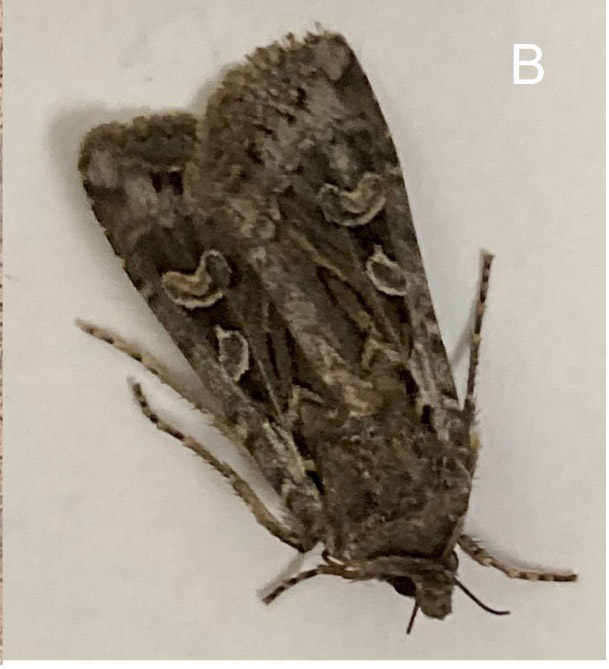Migratory Moths: Invading Homes and Structures
- Jump To:
- Control Around Homes
- Sources:
Currently, Oklahoma is experiencing an increased population of moths entering homes and structures. The two moths that are currently causing homeowners to take notice are Forage Looper Moth (Caenurgina erechtea) and the Miller Moth (Euxoa auxiliaris) (Figure 1 A and B) also known as the Army Cutworm in the caterpillar stage. The Forage Looper Moths are seen in prairie areas where there is an abundance of tall grasses and herbs. While both can be found throughout Oklahoma the Miller Moth is well documented to migrate in mass from East to West going towards the Rocky Mountain regions of the US.
Figure 1a. Forage Looper Moth adult.
Figure1b. Miller Moth adult.
Although the exact reason why these moths only migrate in certain years in mass the most likely reason is the availability of flowering plants that provide nectar. The direction of migration is most likely due to cooler temperatures in the higher elevations. During years where we see increased migrations of these moths the outbreak level usually lasts about five to six weeks beginning in mid-May and going through June however the most intense populations only last approximately two weeks. This year’s migration is at a level that they are picking these migrations up on weather radar in Colorado where most of these moths are headed for the summer (Fig. 2). Although Oklahoma is rarely the destination for these two moths they are emerging from fields throughout Oklahoma, Kansas, and Nebraska.
Figure 2: Blue / purple radar of moth migration captured on the weather radar in Colorado. (Capture date: 5/20/2023; Credit: US National Weather Service Denver / Boulder Colorado).
In general, especially Miller moths, they tend to avoid daylight and will try to find shelter in homes or structures before daybreak. Small entry points such as doors, broken screens, or garage doors not sealed at the bottom are ideal for entry points into structures. Structures that have flowering plants and canopies that maintain humidity or just higher humidities will attract more moths than structures without flowering plants nearby. This is an important aspect of their behavior because they are also pollinators and property owners will have to weigh the benefit of pollination to controlling a temporary nuisance.
Control Around Homes
One important aspect to limit the impact of these migratory moths is to properly seal entryways and windows. If you have screened in patios, then check all screening to make sure there are no gaps in the screen and if your screen doors are not sealed at the bottom or top then modify these openings to reduce the amount of entry points for the moths. If you notice a common entry point or gathering area, then try to reduce the amount of light at night near those areas because these moths are attracted to light.
If you have several landscaping features that include dark shrubs or pine trees, then these will provide shelter for migrating moths and could cause some of moths to remain longer. Also, having flowering plants around any structure will attract these moths. However, it is not recommended to treat these plants with insecticides because this could have a significant impact on other pollinators such as bees.
If a property owner is dealing with these moths inside their structures, then the best method to reduce them is to vacuum them up with a high-powered vacuum such as those used in shops. Insecticides are not recommended because they only have a short-term impact that will still result in the homeowner having to vacuum or remove the dead moths. However, there is a method to attract the moths away from the home and that is to use a bucket partially filled with soapy water (dish detergent is the best option) and place a light over the bucket. The light will attract the moths and the soapy water will kill the moths. It must have soapy water not just regular water to have an impact on the moth population. It is also important to locate these away from entry points to any structure so utilizing an extension cord and hanging the light on a fence away from structures would be a better option rather than placing these light bucket traps near any opening on structures.
There is some evidence that anything that makes a noise similar to jingling keys, crumpling soda cans, or wind chimes that produce similar sounds will disorient the moths away from structures. This is a behavior from the moths that is utilized to avoid predation from bats that use sound to locate the moths. Bats are natural predators of these moths and utilizing some kind of sound in combination with the soapy traps will disturb the moths’ behavior to avoid the structures.
It is important to note that although these are nuisance at this time the intensity of the infestations will decrease as the summer temperatures warm up. Also, these are pollinators which are providing a service to ornamental plants so avoid using pesticides unless they are only directed to structure walls where there are significant infestations occurring within the structure. Always follow insecticide labels and it is recommended that you have a certified pest management professional to aid in the treatment of any structures, especially if treating inside.
Sources:
Cranshaw, W.S. 2014. Miller Moths. Colorado State University Extension.
Forage Looper Moth. 2022.



